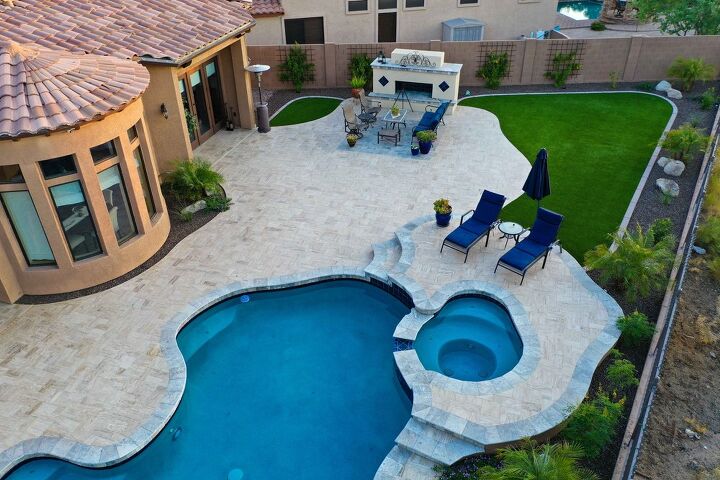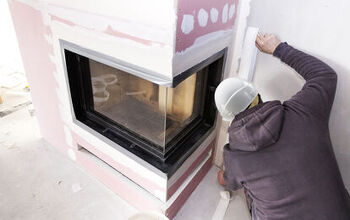Is Travertine Slippery Around Pools? (Find Out Now!)

When it comes to pool safety, few things are as important as making sure that you don’t end up slipping and falling into the pool. The question of how to prevent slips often involves yelling at kids to keep walking and using the right materials. That’s why travertine is a bit of a contention. Does it get slippery when wet, or is that just rumors that should be water under the bridge?
Though it is porous and can absorb a certain degree of moisture, the truth is that it still can become very slippery when wet. Using a special non-slip coating can reduce the chances of people slipping on it. However, travertine is generally not seen as a great choice as a poolside paver. There are better options on the market.
Pool safety is a vital part of your home’s overall safety guidelines. Knowing what travertine can do for you is really important. Here’s the straight dope on this dope pool pavement material…
Do You a Need Pool, Spa, or Hot Tub Contractor?
Get free, zero-commitment quotes from pro contractors near you.

What Is Travertine?
Travertine is a type of paving stone. It’s known for being porous, smooth, and beige. It’s most commonly sold in a tumbled form, and can be used as a patio stone. It’s popular because it gives your patio an old world appeal. While it’s not the most common stone out there, it’s gained a lot of popularity in certain circles over the past 15 years.
Is Travertine Durable?
If there is one thing that travertine is great for, it’s being durable. Even tumbled travertine is notably durable. It doesn’t crack, doesn’t have deep stains, and can handle heavy impacts. That’s why it’s so popular as a deck tile.
Is Travertine Safe To Use Around Pools?
While travertine stones look beautiful, they aren’t the best option for people who want to keep a safe setting around the pool. Travertine does not absorb enough water to make it a good, grippy option for most people. However, there’s more to this than just a matter of slipperiness. Here’s what you need to know:
- Travertine can and does get slippery when wet. It doesn’t absorb the water well enough to be “instant dry” the way that other porous paving stones are. We’ll get into how slippery it is later.
- You would need to coat them with anti-slip coating if you want to use it. Oh, and this coating might not actually stick for too long. So reapplications may be required.
- There have also been cases of people cutting their feet on sharply-cut travertine. There’s a reason why it needs to be installed tumbled. Travertine that’s not properly cut will harm your feet and potentially unsanitize your pool.
- Since travertine is porous, it can also pose a mold and debris risk. You can’t always scrub the debris out of travertine.
How Slippery Is Travertine?
Ceramic and stone manufacturers have a special scale that shows how slippery something is, it’s called a Skid Resistance Value. The lower the resistance, the more slippery it is. SRVs tend to mean different things at different ranges. To make things easier on buyers, they also have a thing called the Pendulum Index.
The Pendulum Index goes from P0 to P5, with the lower numbers denoting a more slippery site. This relates to how well a wet rubber boot can walk on the substance without slipping and sliding. Both SRV ratings and Pendulum ratings are used to tell you if a stone is good for a pool.
Travertine has an SRV rating between 35 to 44, and a Pendulum rating of P3. This leads to a moderate risk of slipping. It’s not the worst, but it’s far from the best. This means that people who are walking at a fast pace may find themselves slipping into the pool.
Should You Use Travertine As Pool Decking?
Honestly, the jury is out on this. Many pool pavers are totally fine with travertine decking despite the fact that it has the propensity to get slippery when wet. Some may even suggest it because they are known for being durable and somewhat easy to clean. However, we’re going to err on the side of caution.
While travertine can look beautiful and stay affordable, there are definitely better options out there. Everyone tends to assume that safety can take a back seat as long as it’s “safe enough,” but it’s always better to choose something that isn’t as risky. So if you want to, you can always use travertine. It’s just that we’re not going to advise you to do so.
If you choose to do so, try to angle it away from the pool. This can help prevent people from falling in, though it can still cause people to get nasty scrapes.
Do You a Need Pool, Spa, or Hot Tub Contractor?
Get free, zero-commitment quotes from pro contractors near you.

Related Questions
What is travertine made from?
Travertine is not a manufactured material. It’s a natural limestone that is typically found around hot springs. The materials inside it include calcium, silica, and calcite. These items swirl together to create a fascinating, one-of-a-kind swirl pattern that people love. While it could be possible to theoretically make travertine, it’s still typically mined from the earth and carved for your home.
What is the best pool decking material?
The best pool decking material on the market is brushed, poured concrete. This is because it’s waterproof, grippy, and remarkably durable. Moreover, concrete tends to be one of the most affordable ones in terms of both installation and repairs. It’s best paired with a coat of paint engineered for extra grip. However, most types of poured concrete will not be slippery unless they’re polished. So, even paint-free is fine.
Is travertine out of style?
Though travertine was one of the hottest paving stones from the 2000s and 2010s, demand has started to slump. Many people find it to be too risky to use in pools where small children or elderly individuals will be. Moreover, it’s become somewhat dated. While it’s not as trendy as it once was, travertine still has a fairly loyal following among pool designers. So, it’s not as dated as other home accessories could be.
Related Guide

Ossiana Tepfenhart is an expert writer, focusing on interior design and general home tips. Writing is her life, and it's what she does best. Her interests include art and real estate investments.
More by Ossiana Tepfenhart





















![How To Reset A Whirlpool Cabrio Washer [In 5 Easy Steps!]](https://cdn-fastly.upgradedhome.com/media/2023/07/31/9076531/how-to-reset-a-whirlpool-cabrio-washer-in-5-easy-steps.jpg?size=350x220)





